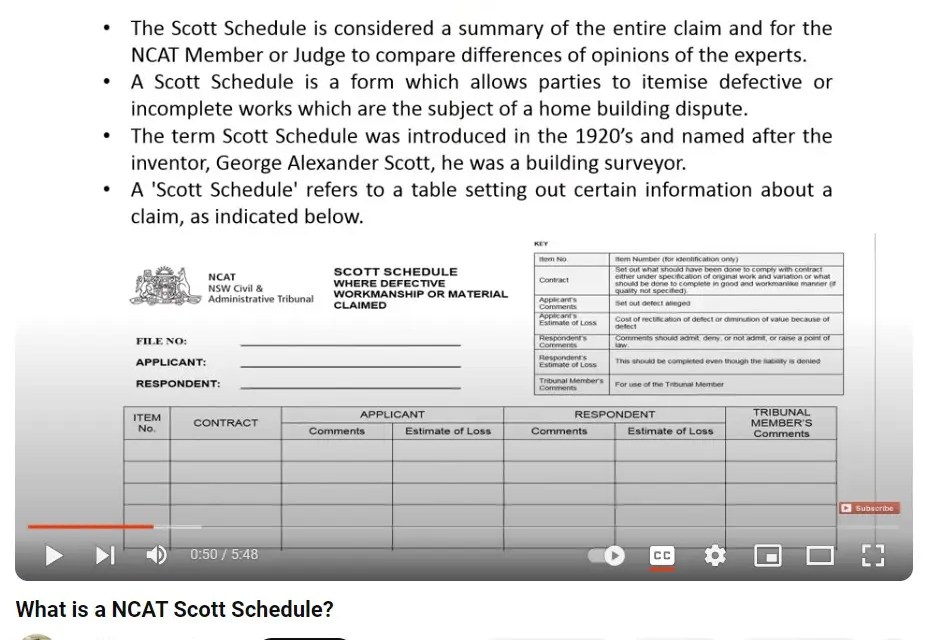What is a Scott Schedule?
An NCAT Scott Schedule is a structured document used by the New South Wales Civil and Administrative Tribunal (NCAT) to manage and resolve disputes, particularly in building and construction cases. Named after the British engineer George Alexander Scott, this schedule helps to systematically present and compare the claims and defenses of the involved parties. Its primary purpose is to break down complex issues into manageable parts, facilitating clarity, organization, and efficient resolution of disputes.
Structure of an NCAT Scott Schedule
The NCAT Scott Schedule typically includes the following elements:
- Item Number: Each disputed issue is assigned a unique identifier for easy reference.
- Applicant’s Description of Issue: A detailed description of the problem or defect as seen by the claimant.
- Applicant’s Claimed Cost: The amount the claimant believes is required to rectify the issue.
- Respondent’s Description of Issue: The respondent’s counter-description or denial of the issue.
- Respondent’s Offered Cost (if any): The amount the respondent is willing to pay or their assessment of the cost.
- Tribunal’s Decision: The final decision made by the tribunal regarding each issue.
Purpose and Benefits
The primary purpose of the NCAT Scott Schedule is to clarify and streamline the dispute resolution process. By organizing the issues in a structured format, it ensures that both parties can see each other’s positions and the evidence supporting those positions. This transparency can lead to several benefits:
- Clarity and Organization: The schedule provides a clear structure that makes complex issues easier to understand and address.
- Facilitation of Settlement: Seeing detailed positions can encourage negotiations and settlements without the need for a full tribunal hearing.
- Efficiency in Hearings: If a case proceeds to a hearing, the tribunal has a well-organized document outlining the key points of dispute, which can expedite the process.
- Systematic Evidence Presentation: Ensures that all relevant evidence is presented in a systematic manner, aiding the tribunal in making informed decisions.

Example of Use
In a typical scenario, a homeowner might claim that a builder’s work resulted in several defects in their house. The homeowner lists issues such as a cracked wall, a leaking roof, and incorrectly installed flooring in the Scott Schedule, along with estimated costs for rectifying these issues.
The builder, in response, provides their perspective on each issue, possibly acknowledging some defects but disputing others. For instance, the builder might argue that the wall cracks are cosmetic and not structural, offering a lower repair cost. They might also claim that the roof leak is due to poor maintenance by the homeowner and that the flooring was installed correctly according to the contract.
The tribunal then reviews the Scott Schedule, examining the evidence and arguments from both sides. After consideration, the tribunal fills in the decision column, resolving each issue based on the evidence presented.
Conclusion
The NCAT Scott Schedule is a crucial tool in resolving building and construction disputes. By providing a structured and transparent format for presenting claims and defenses, it facilitates a more efficient and fair resolution process. Whether used to encourage settlements or to streamline tribunal hearings, the Scott Schedule plays a vital role in managing and resolving complex disputes in the New South Wales Civil and Administrative Tribunal.


